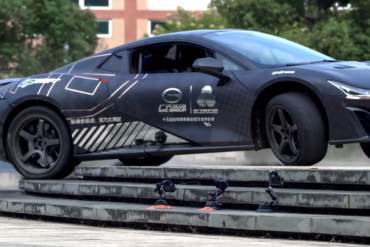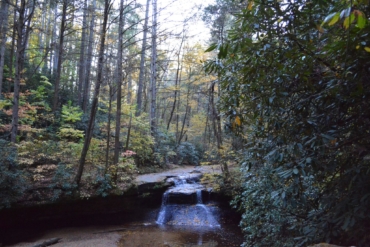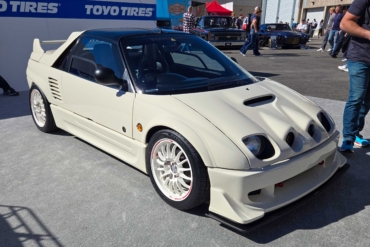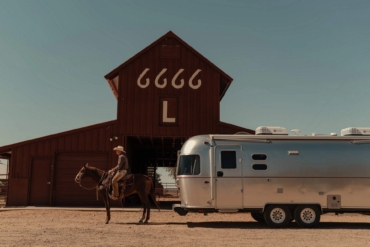A rare 1988 Mitsubishi Delica has hundreds of custom features and modifications, almost too many to number (and maybe more than any other van of its kind in the world).
The steering wheel is on the right side. It removes at a click when the van stops, a custom feature added to thwart any attempt by a thief.
“People look inside and think, ‘why is there no steering wheel?'” said Sam Salwei, owner of the uber-modified Mitsubishi Delica, aka the “SlackerVan.”

Salwei, 40, lives in the 1988 van with partner Raquel Hernández-Cruz, 41. Over the past 4 years, the pair has traversed the continent to teach, slackline, and explore as leaders of the YogaSlackers group.
They have mechanic friends around the country and a litany of gear companies involved in a mission to make the van perfect for travel and life on the open road.
The couple is constantly tweaking, adding, and modifying the Japanese-made van. It is to a point where Salwei believes his Delica may be the “most modified” on the entire planet.

SlackerVan: From Leaf Springs to LED
The details of this van are endless, from its custom leaf springs, upgraded braking system, and adjustable front shocks, to solar panels and three Yakima gearboxes on the roof.
Inside, there are comforts and necessities like a bed, sink, screens, camera mounts, LED lights, and dozens of USB ports scattered about for power.

The rear bumper is made of cedar. The flooring inside is cork. A small Moai statue from Hanga Roa stands near the driver seat — “to protect us,” Salwei said. And there is a prayer wheel from Kathmandu in back, spinning as they drive.
The van is so feature-rich that Salwei printed and affixed instruction labels throughout the interior. “We can hardly remember how to use everything,” he said.
Example labels include: “Water fill up and use”; “Slider solar panel warning”; “Light zones”; and “Do not operate decaffeinated.”

An oversize sticker on a window reads: “This is your classroom” in large type, hinting that life as a vagabond explorer requires embracing anything ahead that comes your way.
The message was transferred from Salwei’s former vehicle and home, a 1988 Ford Festiva dubbed the PeaceLoveCar. It has its own feature film and was profiled in a 2013 GearJunkie article.
After life in the Festiva, the Delica felt large. But for most people, a 66-square-foot interior would give new meaning to the term “tiny home.”

The couple sleeps on a bed in the back of the van with a 4-inch latex mattress from KTT Enterprises. A tiny kitchen has a sink as well as a modified Engel freezer and fridges to keep food fresh. They cook with a single-burner induction stove near the bed.
Salwei and Hernández-Cruz travel year-round and through all climates. Temps can be below zero to past 100 degrees. Fans and vents help circulate air. They have a 12v DC air conditioner unit.
For cold weather, thermal modifications include Aerogel-impregnated foam, LizardSkin spray-on insulation paint, and wool insulation from Havelock in the walls.
Mitsubishi Delica for Van Life
The van is 13 feet long and weighs about 7,200 pounds. The diesel engine is operated via a manual five-speed transmission. As is standard in Japan, it’s set up with its steering wheel on the right. “The hardest part is that the windshield wiper and blinker controls are reversed,” Salwei said.

It is equipped with a selectable 4×4 mode with low range (LSD differential with 4.875 gears). The braking system has dual-piston calipers, larger rotors, and braided steel lines — all upgrades for performance and safety. Its suspension includes Rancho rs9000 adjustable front shocks, rear air shocks, bigger torsion bars, and custom leaf springs.
As this is a 1988 vehicle, there is no computer controlling the engine. Instead, the pair rely on a system of gauges to monitor turbo boost, exhaust gas temp, water temp, and air shock pressure.

A snorkel air intake is on the side “to be able to cross rivers, though not that Raquel will let me,” Salwei said, laughing. (It also keeps the air going into the engine cleaner.)
The tires are Goodyear Duratrac. “They are awesome,” Salwei said. “They are quiet, can drive on ice, rocks, and can run higher pressure to handle the heavier camper build-out.”

On the Road (With the Comforts of Home)
Salwei has cut nine holes in the van for vents, a slide-open roof ragtop, and other modifications. A major upgrade was obtained by replacing the right-side middle window with a bump-out, dual-panel Tern window. The window provides extra space inside and comes with mosquito nets and privacy curtains.
A bed takes up the back of the van. Its plywood platform supports a natural-rubber pad with a memory-foam topper, all cut to fit and measuring a bit smaller than a full-size bed.

A dehumidifier on the ceiling automatically turns on to mitigate condensation while sleeping. There’s a 12-volt ceiling fan over the kitchen. A sailboat mushroom-style vent between the kitchen window and the cargo door gives adjustable airflow.
Power comes via solar panels from Merlin (1,065 watts). Salwei picked them for durability, noting that rather than standard busbar connectors between cells the flexible Merlin panels have over 1,000 connection points and will not get damaged by vibrations.
The panels are affixed to the Yakima boxes, three in all, plus a bonus slide-out solar panel that is bonded to an aluminum honeycomb board and pulls down to cover the windshield when the vehicle is stopped. “Privacy and power,” Salwei said.

Keeping It Fresh
You might wonder how you keep such a small, do-it-all space feeling fresh and clean. After all, it’s basically a bedroom, living room, kitchen, and bathroom all rolled into one.
Salwei said that 5 years living out of the Festiva taught the couple the importance of maintaining a clean and organized space.
“Onions are banned from all our vehicles, raw or cooked,” he said. “We use shallots instead. Their scent doesn’t seem to stick to the van or us as onions do.”
He also noted dirty clothing is stored in dry bags before the two launder it with Defunkify. Plus, all smelly shoes stay off the van. In additon, the Delica has a number of fans to move air around.
“And for really smelly stuff,” Salwei told us, “we treat with Sink the Stink, an old trick that Raquel picked up while working as a scientific SCUBA diver.”
Lastly, he said, they use a diffuser after cooking and while sleeping.
“We love to go to sleep with a combination of clove, cinnamon, ginger, and citrus. The van smells lovely until someone decides to fart. But even then, it only usually lasts a few minutes or — so we think!”
Solar, Lithium, and Electrified Infrastructure
The electric system is complex and custom, with a 2,000-watt Compact Victron inverter/charger, 300-watt fanless Morningstar SureSine wave inverter, solar-charging controllers, and a 210-amp Sterling alternator-to-battery charger.
Heated 400Ah Battle Born batteries store the power. They are monitorable via a Cerbo GX Victron Computer Interface and a Victron Battery monitoring gauge with a Bluetooth dongle.
For communication far from cities, a WeBoost cell-signal amplifier and a marine antenna give extra reception bars. Salwei and Hernández-Cruz need to stay in contact to run the YogaSlackers from anywhere. As such, they have multiple cell plans — AT&T, Verizon, and (at times) Google Fi SIM cards — that they use to tether the internet to their devices.

A cabinet under the kitchen sink includes charging ports for camera batteries, headlamps, and walkie-talkies. Electric warmth comes from 12v DC radiant heat panels at the foot and head of the bed.
A water heater with a 2.6-gallon insulated tank offers warm handwashing or a shower if you pull the hose-equipped faucet out the window on the side.
Kitchen Sink Included
A full (but tiny) kitchen is behind the driver’s seat. The couple can prepare food, cook, and wash dishes.
The well sink has a homemade cover/cutting board. The induction stove has a single burner and is usable with the windows open.
Wind is not a problem, Salwei said. “We use cast iron cookware and a pressure cooker; this helps us to conserve energy.”

Water is filtered via a system that converts dirty water to drinkable. It’s a complex chain with a 50-micron pre-filter, followed by a 5-micron carbon block, to a 1-micron carbon block. Finally, the water goes through an LED disinfection system, ready for drinking or washing up.
The Engel MD-14F fridge-freezer was modified to increase its height, “mainly because in its original configuration, it is not tall enough for milk or juice containers,” Salwei explained. “We replaced the original fridge top with a homemade wood box insulated with aerogel foam.”
Cabinets in the kitchen are simple plywood construction. Storage boxes are made with corrugated plastic, and they stay in place by hidden key-retractor cords. For looks, the boxes are covered in an ocean-wood pattern wallpaper.
Night Vision
Illumination comes from dual-beam J.W. Speaker and Vision X LED headlights as well as Rigid Industries lights mounted on the rear bumper. A night-vision system from FLIR gives a real-time, forward-looking infrared view. You can drive at night and see via a Sony tablet screen mounted on the dash.
“We got the system because we do a lot of driving in the dark in areas with little to no street illumination,” Hernández-Cruz said. “We almost hit a black cow standing perfectly still in the middle of the road one night, and there have been countless deer, a herd of bison on the road, and much more.”

The FLIR PathFindIR II picks up heat signatures like animals on or near the road, and it emits a loud beep as a warning. Onscreen, the system places a yellow box around an infrared-highlighted animal.
“It also shows you the whole landscape, including clouds and mountains at night,” Hernández-Cruz continued. “We saw the Grand Tetons in the middle of the night!”
Lighting inside the van is an organized tangle of cords, switches, and eight separate zones. More than 50 feet of LED strip-lighting with adjustable colors and intensity light up all corners and nooks, including even the interior of the Yakima boxes on the roof.

Securing the SlackerVan
Keeping the van safe as they travel around the continent is a priority. This is the couple’s home and business base, with most of their worldly possessions along for the ride at all times over the van’s four wheels.
Beyond the Delica’s factory locks, the driver door, passenger door, sliding door, and rear door are all equipped with burly Master hasp locks.
The keyless locks open with a code, and the big hasps on the doors can discourage thieves from bashing in a window, as they cannot simply reach in and unlock a door.

Bikes are secured on the back with a “big ass chain.” The 9/16″ diameter hardened steel, square link motorcycle chain is made by ABUS.
A HitchSafe Key Vault is embedded on the bumper. This tiny safe on the exterior of the van lets them leave the keys while hiking or out in the woods.
During group activities, whoever is back to the vehicle first can open the vault, spin the door lock combination code, and start the ignition.
Gear-Hauling Prowess
Yakima has been a longtime partner of the project. The company provided more than a dozen products for the van, including a roof rack base system that Salwei explained as a “layered sandwich of Yakima Tracks with two layers to increase height and fit the A/C unit under the roof basket.”

Overall, there are six Yakima HD crossbars, Yakima SkyLine towers, a Yakima track system, and a windshield fairing. Three gearboxes are on top, the company’s SkyBox and RocketBox models.

Bikes mount on a rear rack, which is connected to a hinged unit that swings the bikes out of the way when the rear door needs to open. Finally, an awning, the Yakima SlimShady, pulls 6 feet out to provide instant rain protection or shade.
Some of the photos in this article show the EXO system from Yakima. This new configuration on the rear of the van (added this fall) has a swing-out base with a “second-level” EXO TopShelf unit. This lets the pair connect a Yakima bike mount and an EXO GearLocker, which works as another cargo box, though much easier to access and reach, as it’s situated at knee height on the back of the van.
Beyond the commercially available gear storage, Salwei and Hernández-Cruz built an “integrated bike organizer” on the rear door. The system holds helmets, bike shoes, and gear and keeps it all immediately accessible and organized when the rear door swings up.
“Everything has its place,” Salwei said. “We are always ready to go!”
Where the Money Meets the Road
Of course, all of this didn’t happen overnight, nor was it free. Salwei said the couple paid $9,100 for the van, sight unseen. At the time, it had a little rust and a bad alternator.
Being established gear reviewers and leading the YogaSlackers brand, they received some of the gear from sponsors (like Battle Born Batteries, Yakima Racks, Merlin Solar, FLIR, and Luminor UV). But much of the labor was sweat equity, and the two did the work in small chunks over time.
Even with the sponsorship, Salwei and Hernández-Cruz confirmed they have spent “a small fortune” building out the Delica — though admittedly, they prefer not to think about the exact number.
“A few months ago someone asked us to give them a number for it to be sold. We couldn’t come up with one — mainly because, how do you put a price on endless sweat, blood, and a lot of tears lost in the process of building our home on wheels?” Salwei asked.
“But I gotta say, if someone were to offer us more than $100,000, we’ll probably restart the tear production in another vehicle.”
‘We must have inherited a nomadic gene’
by Raquel Hernández-Cruz
When you live in a van, a common question is, “Why travel?” To us, this question is similar to asking anyone else, “Why breathe?” Traveling is our way of living.

I am confident to say that there is a group of people that cannot thrive in one place, grow roots, and flourish. This group — to whom we belong — must have inherited a nomadic gene from our ancestors.
Thousands of years ago, our species survived thanks to their ability to be mobile, malleable, and travel on a daily basis. They experienced the world one day at a time, without set schedules and daily routines other than those set by biological needs.
That is us.
Sam has been living out of a vehicle since 2009. I joined him in 2012. We first lived out of a 1988 Ford Festiva. We roamed North America teaching yoga, slacklining, acro-yoga, and leading adventure-based retreats. After 5 years of living together in a tiny car, we decided to upgrade to a larger vehicle.
Our requirements were simple: a larger bed and space to move around. Sam really wanted a 4×4 vehicle with a small footprint and had been keeping an eye on the Delica. We got lucky to find one within a few days of searching.
Purchasing the Delica was the easy part. Making sure a 1988 vehicle works perfectly is a different story. When we bought the van, it had a faulty alternator. The first trips required us to stop to charge once a day. It gave us the opportunity to travel slowly, sleep inside our new stock seven-passenger van, and plan our build.
Soon after, the U joint broke, taking with it the drive shack, diesel can, and transfer case. Our previous experience living and fixing the 1988 Festiva had given us the tools required to not freak out (at least not too much) and to realize “we got this.” Five days after the breakdown, we were ready to move again.
I wish I could say that building and maintaining a vehicle while living in it is easy. It is not. It is the most challenging adventure we have ever taken. The reason it works for us is because we have an array of friends across the U.S. willing to lend tools, garages, time, and skills.

Our first build took 11 days. We installed the first iteration of our roof rack system, electric system, kitchen layout, and bed frame in Rhode Island. We knew that we wanted to live in the van for a few months before finalizing the details, as the layout written on paper needed to be proven experientially.
That proved to be true! After a few months, we realized we wanted to switch our under-the-bed storage system, as one of many examples.
Our second build took place in California. There we added a ragtop to access the roof boxes from the inside of the van and redid the bed frame and storage.
We added a pop-out extension to the driver’s side of the van. The extension allowed us to add a large window to vent the van while cooking and (most importantly) to switch our sleeping position from long ways in the van to sideways.
At this time, it had been almost a year since we bought the van and we had not yet done any major trips. But after installing an air compressor, we hit the road and traveled all the way to the Arctic Circle. This tour allowed us to test our systems and determine what else needed to be improved.
A little over a year later, we returned to California where we spent 6 months during the pandemic working on a new set of improvements.
I wish I could say the build is done. But as long as we continue traveling in this van, we will continue seeing new ways to make it more comfortable, functional, and mechanically sound.
That’s part of the fun! Sam and I plan to continue traveling and building our “most modified” Mitsubishi. The adventure, and our life, continue on the open road.
— Follow Raquel and Sam at YogaSlackers.com







